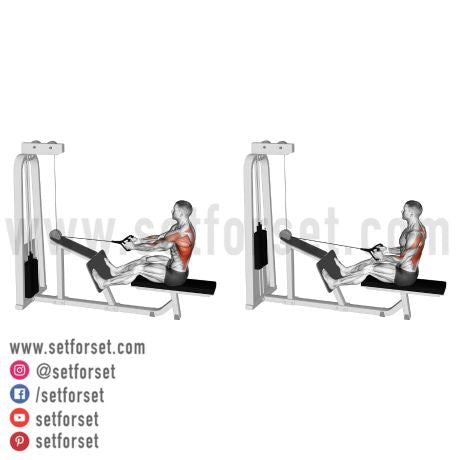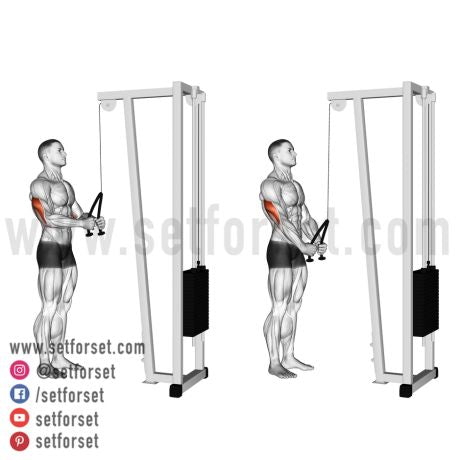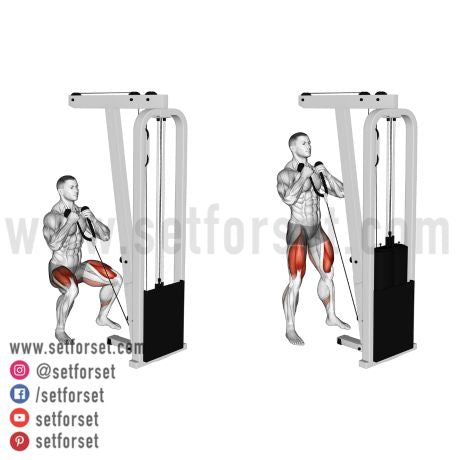Fitness is trendy. What’s popular in a single moment will be gone the following. The fitness graveyard is full of fad diets, odd pieces of kit, and strange workout routines. Nonetheless, certain things have a way of coming back around. Cable training is on this trajectory. At times, it gets brushed aside by the “free weight only” crowd. But cable training is in straight away, and for good reason. Cable machines are versatile tools that provide a spread of fantastic exercises. It’s never an either-or debate. You possibly can have your barbells and still throw in some cables and machines.
In this text, we’ll explore a collection of effective cable movements, highlighting their unique advantages and providing step-by-step instructions for correct execution. If you would like to expand your workout routine, incorporating these cable exercises can aid you take things to the following level.
Table of contents:
- 18 Best Cable Machine Exercises By Muscle Groups
- Chest
- Back
- Shoulders
- Biceps
- Triceps
- Legs
- Abs
- 3 Things I Like About Cable Machines
- FAQs
Best Cable Machine Exercises
If you would like to add more practical cable exercises to your training program, listed below are 18 to try.
Cable Chest Exercises
1. Cable Crossover
The cable crossover is a staple muscle-building movement. Bodybuilders find it irresistible because you possibly can goal the chest from various angles and maintain constant muscle tension. Other than that, it is easy on the joints and creates a nasty chest pump if done right. Throw this in at the top of your chest workout.
Here’s tips on how to do it:
- Set the cable pulleys to the specified height and stand in the middle of the cable crossover station with feet shoulder-width apart.
- Grab the D-handle and step forward barely.
- Keep your chest up and a slight bend in your elbows.
- Bring your hands together and squeeze your chest on the movement’s peak, then slowly return to the starting position while controlling the resistance.

2. Cable Chest Press
The chest press is one other effective muscle-building cable exercise. It is not a barbell bench press, but you possibly can still move some weight around. The advantage of a cable chest press is that you would be able to use a heavier load than on a cable crossover. The secret is to get a superb stretch at the underside and press to a full extension at the highest.
Here’s tips on how to do it:
- Stand looking away from the cable machine, grab the handles, and step forward barely.
- Along with your elbows bent and your wrists aligned together with your elbows.
- Press until your arms are fully prolonged.
- Squeeze your chest on the movement’s peak, then slowly return to the starting position.
Cable Back Exercises
3. Seated Cable Rows
Seated cable rows are one other classic bodybuilding exercise. You possibly can see Arnold cranking away at these in Pumping Iron. Although the movement is straightforward, you have got a number of options to customize it to your liking. You possibly can mess around with the handle, choosing a detailed or wide grip – each work. Or, you possibly can do them one arm at a time.
Here’s tips on how to do them:
- Sit on the cable row machine together with your feet flat on the footplate and knees barely bent.
- Grab the handle and pull it toward your upper abs, squeezing your shoulder blades together on the movement’s peak.
- Slowly return to the starting position.
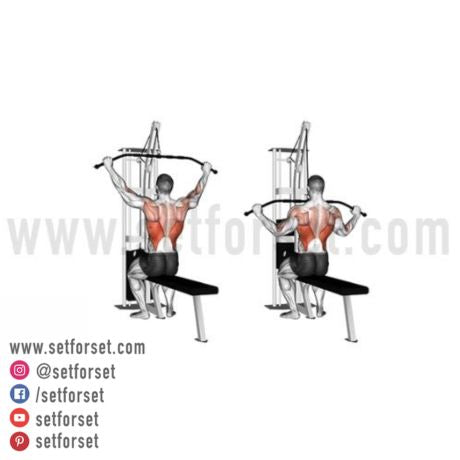
4. Wide-Grip Lat Pulldowns
No list of one of the best cable exercises can be complete without the lat pulldown. Actually, no list of one of the best back exercises period can be complete without lat pulldowns. They’re excellent and must be an element of most of your back workouts.
Here’s tips on how to do them:
- Sit on the machine together with your thighs secured under the pads and grab the bar with a large overhand grip.
- Keep your chest up, lean back barely, and pull the bar toward your upper chest, specializing in squeezing your shoulder blades together.
- Slowly return the bar to the starting position, controlling the movement.
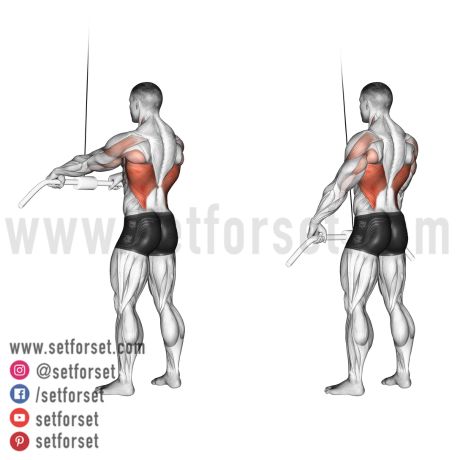
5. Straight Arm Pulldowns
Straight-arm pulldowns are underrated. While less popular than other back exercises, the straight-arm pulldown targets the lats without significant involvement from other muscles. This isolation might help individuals higher give attention to and develop their lats, particularly those that feel numerous back exercises of their biceps. You possibly can put them in the beginning of a back workout as an activation exercise or throw them in at the top as a finisher.
Here’s tips on how to do them:
- Face the cable stack and grab the bar with an overhand grip.
- Keep your arms straight and extend them down in front of your body.
- Pull the handle down towards your thighs, specializing in using your lats to regulate the load.
- Slowly raise the bar back to the starting position, keeping tension in your lats throughout the exercise.
Cable Shoulder Exercises
6. Cable Face Pulls
Face pulls are an exercise that just about everyone would profit from doing more of. They primarily goal the customarily neglected rear delts and, to a lesser extent, the traps and rhomboids. Moreover, the rotational aspect of the movement encourages external shoulder rotation, helping to counteract the consequences of poor posture and strengthening the muscles liable for stabilizing the shoulder joint.
Here’s tips on how to do them:
- Set the cable pulley with a rope attached at face height or barely above.
- Stand toward the cable machine and grab the rope with an overhand grip.
- Step back barely, keeping your feet shoulder-width apart and knees barely bent.
- Pull the rope toward the highest of your head, keeping your elbows high. Pause briefly on the movement’s peak before returning to the starting position.
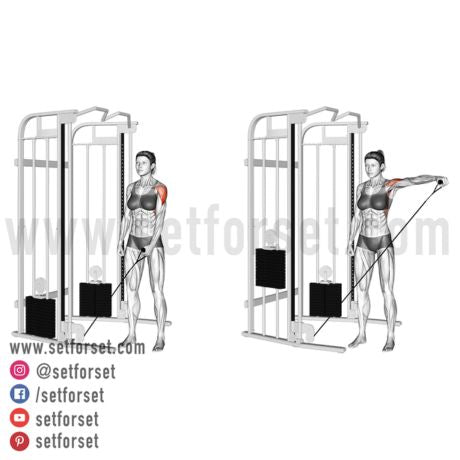
7. Cable Lateral Raise
Two principal muscle-building exercises exist for the side delts – dumbbell lateral raises and cable lateral raises. Nonetheless, unlike traditional dumbbell lateral raises, where the strain is less at the underside of the movement, cable lateral raises maintain resistance from start to complete as a result of the cable’s constant tension. This continuous tension helps to maintain the lateral deltoids engaged throughout the exercise, promoting muscle activation and growth. Moreover, the cable allows for smooth and controlled movement, reducing the likelihood of momentum taking on.
Here’s tips on how to do them:
- Set the cable pulley to a low position and connect a D-handle.
- Stand next to the cable machine together with your feet shoulder-width apart.
- Grab the handle together with your far hand and barely bend your elbow.
- Keeping your arm straight, raise it to the side until it’s parallel to the bottom, leading together with your elbow.
- Slowly bring the cable back to the starting position with control.
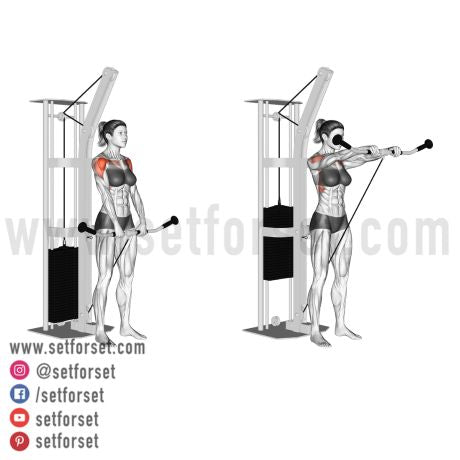
8. Cable Front Raise
The front delts are worked quite a bit on all pressing movements. So, should you do numerous bench presses and shoulder presses, the necessity to add front raises into the image is minimal. Nonetheless, if you have got elbow pain or triceps soreness and still wish to train the front delt, the cable front raise is a superb option.
Here’s tips on how to do them:
- Set the cable pulley to a low position and connect a D-handle.
- Stand away from the cable machine together with your feet shoulder-width apart.
- Grab the handle with one hand and barely bend your elbow.
- Lift the handle directly in front of you until it’s parallel to the bottom.
- Lower the handle back to the starting position under control.
Cable Biceps Exercises

9. Standing Cable Curls
It’s hard to beat the usual cable curl. As with all cable exercises, the constant tension on the muscle with this movement is a major advantage over a conventional barbell curl. Unlike free-weight curls, the cable biceps curls don’t lose tension at the highest. The secret is using good form. Control your elbow; don’t let it drift forward as you curl the load.
Here’s tips on how to do them:
- Set the cable pulley so there’s tension together with your arms straightened and connect a straight or cambered bar.
- Stand toward the cable machine together with your feet shoulder-width apart and knees barely bent.
- Grab the bar together with your palms facing up and arms fully prolonged. Keeping your elbows near your sides, curl the bar towards your shoulders, squeezing your biceps at the highest.
- Slowly lower the load back to the starting position, maintaining control over the resistance.
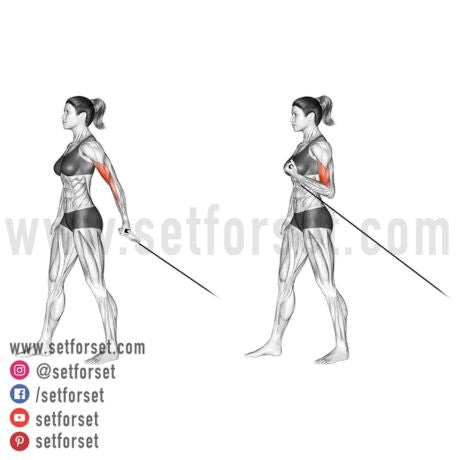
10. Behind The Back, One Arm Cable Curls
Also called “Baysian Curls,” this unique exercise increases tension at the height biceps contraction. Performing the curl behind the back emphasizes the stretched position greater than standard bicep curls, potentially resulting in greater muscle activation and growth.
Here’s tips on how to do them:
- Set the cable pulley to a low position and connect a single handle.
- Stand away from the cable machine, feet shoulder-width apart, and knees barely bent.
- Grab the handle with one hand, palm facing away out of your body, and extend your arm straight down. Keeping your elbow at your side, barely lean forward and curl the handle towards your shoulder, squeezing your biceps at the highest.
- Slowly lower the load back to the starting position, maintaining control over the resistance.
Cable Triceps Exercises
11. Triceps Pushdowns
Triceps pushdowns are a classic triceps builder, and it is easy to see why. They work. The sweetness is that pushdowns goal the triceps without engaging other muscle groups. So, throwing them in at the top can finish the triceps without adding more stress to the chest or shoulders after doing heavy compound exercises, like close grip bench presses, dips, or skull crushers.
Here’s tips on how to do them:
- Stand facing the cable stack with feet shoulder-width apart and knees barely bent.
- Grab the straight bar or rope attachment.
- Keep your elbows near your sides and push the bar or rope downward until your arms are fully prolonged, specializing in contracting your triceps.
- Slowly return the bar or rope to the starting position, maintaining control over the resistance and keeping tension on the triceps throughout the movement.

12. Overhead Cable Triceps Extensions
Overhead cable triceps extensions have all of the benefits of a triceps pushdown, plus yet one more. Putting your arm overhead emphasizes the long head of the triceps, which is the most important portion of the muscle. I like to recommend doing not less than one overhead triceps exercise each week.
Here’s tips on how to do them:
- Adjust the cable pulley to a low position and use a rope or a straight bar attachment.
- Stand away from the cable machine with feet shoulder-width apart. Grab the rope or bar with an overhand grip, lean forward, and extend your arms overhead, elbows pointing forward.
- Maintain a forward lean as you lower the rope or bar behind your head.
- Extend your arms back to the starting position, specializing in contracting your triceps throughout the movement and maintaining control over the resistance.
Cable Leg Exercises
13. Cable Squat
The cable squat is an exercise that only a number of people do. There may be a limitation in how much load you should utilize, but they’re an efficient exercise nonetheless. The cable squat provides constant resistance throughout the movement, difficult muscles in each the concentric and eccentric phases. Plus, the cable’s direction of pull creates a singular resistance pattern, which might engage muscles in a different way and offer a novel stimulus for muscle growth.
Here’s tips on how to do them:
- Stand toward the cable machine with the pulley set at the bottom position and connect a rope handle.
- Hold onto the rope in a goblet position and squat down as if sitting back right into a chair.
- Keep your chest up, knees tracking over your toes, and lower until your thighs are parallel to the bottom or barely below.
- Drive through your heels and extend your hips to return to the starting position, squeezing your glutes at the highest.

14. Cable Romanian Deadlift
The cable Romanian deadlift is a sneaky, difficult exercise. It’s going to light your hamstrings up should you can get in the proper position, often a number of steps back from the cable stack. Use good form, but be daring and go heavy on this one.
Here’s tips on how to do them:
- Stand toward the cable machine with the pulley set at the bottom position and connect a handle of your selection.
- Grab the bar together with your palms facing down, and stand tall with feet hip-width apart. Take a number of steps back.
- Hinge at your waist while keeping your back straight, lower the handle towards the bottom, feel a stretch in your hamstrings, and maintain a slight bend in your knees.
- Drive your hips forward and return to the starting position, squeezing your glutes at the highest.
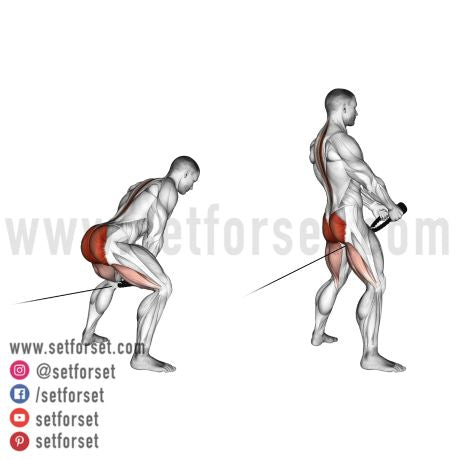
15. Cable Pull Through
The cable pull-through is one other classic movement utilized by nearly everyone. It’s even popular in powerlifting circles. The pull-through targets the posterior chain, including the glutes, hamstrings, and lower back.
Here’s tips on how to do them:
- Set the cable pulley to a low position and connect a rope or handle.
- Stand away from the cable machine with feet shoulder-width apart and grasp the handle between your legs. Take a number of steps forward.
- Hinge on the hips by pushing them back while keeping your chest up and knees barely bent.
- Pull the handle through your legs by extending your hips and squeezing your glutes, then return to the starting position while maintaining tension within the hamstrings and glutes.
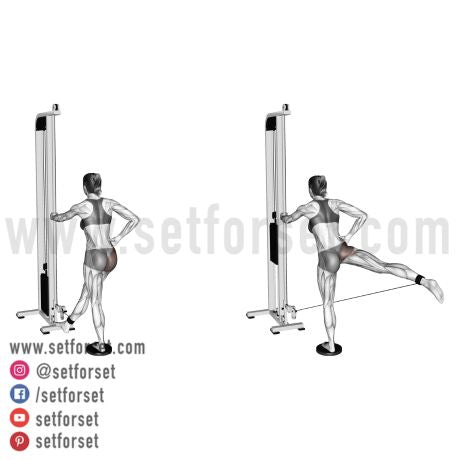
16. One-Legged Cable Kickbacks
If you would like to get your glutes big and powerful, the kickback is considered one of the movements you might want to do. Kickbacks isolate the glutes one leg at a time, enhancing balance and symmetry. Furthermore, they facilitate a greater range of motion than traditional hip hinge exercises. The cable’s attachment point allows for a deeper stretch within the glutes and hamstrings at the underside of the movement, promoting greater muscle activation and suppleness within the posterior chain.
Here’s tips on how to do them:
- Attach an ankle cuff to the machine and adjust the pulley to the bottom position.
- Face the machine and connect the cuff to your ankle, standing on the alternative leg with a slight bend within the knee.
- Hold onto the machine for support and kick your cuffed leg backward, keeping it straight and in keeping with your body.
- Squeeze your glutes at the highest, then lower your leg back to the starting position with control.
Cable Ab Exercises
17. Cable Crunches
By way of ab exercises, it’s hard to beat cable crunches. Their highest quality is providing adjustable resistance, allowing for straightforward progressive overload. Remember, the abs are like several other muscle within the body. For them to grow, you need to constantly challenge them with heavier weights.
Here’s tips on how to do them:
- Attach a rope handle to a high pulley of the cable machine and kneel facing the machine.
- Grab the rope handles and produce them to your brow, keeping your elbows bent.
- Contract your abs and flex your spine forward, bringing your elbows towards your thighs.
- Pause at the underside for a second, then return to the starting position, keeping tension on the abs throughout.
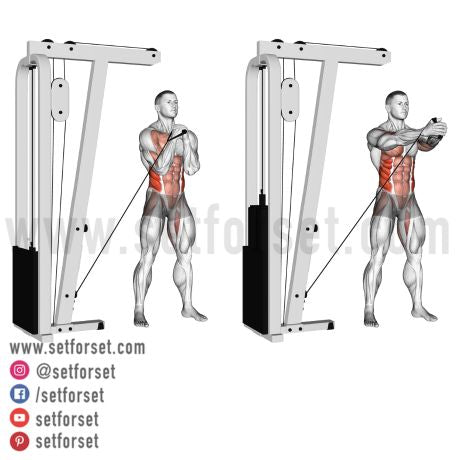
18. Cable Pallof Press
The cable Pallof press is less well-known than cable crunches but is equally effective. The Pallof press emphasizes anti-rotation and core stability, promoting higher functional strength and injury prevention. If you would like to lift heavier weights or perform higher in a sport, do Pallof presses consistently.
Here’s tips on how to do them:
- Set the cable pulley to chest height and connect a D-handle.
- Stand perpendicular to the cable machine with feet shoulder-width apart and grasp the handle with each hands at chest level.
- Extend your arms fully in front of you, resisting the rotational force of the cable.
- Hold the prolonged position briefly, then return to the starting position with control, maintaining stability through the core and resisting rotation.
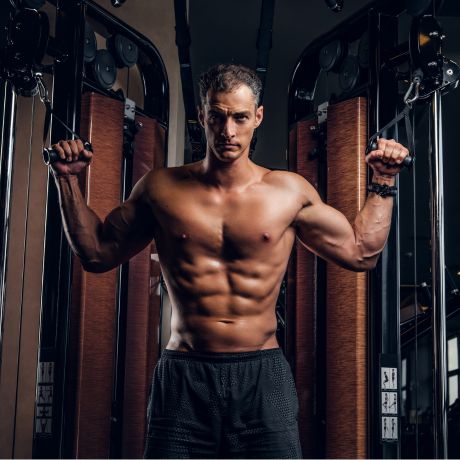
3 Things I Like About Cable Machines
Listed below are my three favorite things about cable machines.
1. Constant Tension
Constant tension is arguably essentially the most significant advantage of cable machines. It means your muscles are continuously working hard throughout all the range of motion. On some barbell exercises, comparable to a barbell curl, the strain is larger at the underside than at the highest as a result of gravity. On cable bicep curls, that is just not the case.
2. Can Safely Push Closer to Failure
With cable machines, pushing your muscles closer to failure is safer. For instance, there’s less probability you’re going to get injured going to failure on a cable crossover than a barbell bench press. Besides dropping the bar on yourself, a barbell bench press can be tough on the joints and connective tissue.
3. Easy on the Joints
Cable machines are your best friend should you are a banged-up older lifter. They’re gentle in your joints because they supply smooth and controlled movements. Plus, unlike barbell and dumbbell exercises, cable machines have more stability. Although this is typically seen as a negative, it might be helpful for keeping your joints healthy and even targeting specific muscles.
FAQs
Do you have got more questions on cable machines? Let’s answer them.
Are you able to construct muscle with just cables?
Yes, you possibly can construct muscle only using cables. Cable machines provide constant tension and adjustable resistance, making them effective for muscle growth. A muscle can only detect tension. It doesn’t matter if the strain comes from a barbell or a cable machine exercise.
Are cables pretty much as good as free weights?
Cables will be as effective as free weights for constructing muscle should you push each set near failure. That said, cables are an amazing compliment to a barbell routine.
What’s a drawback of cable machines?
One drawback of cable machines is that you simply are limited by how much load you should utilize on certain exercises. For instance, it is tough to overload the lower body muscles enough with only cable work to grow the quads, hamstrings, and glutes.
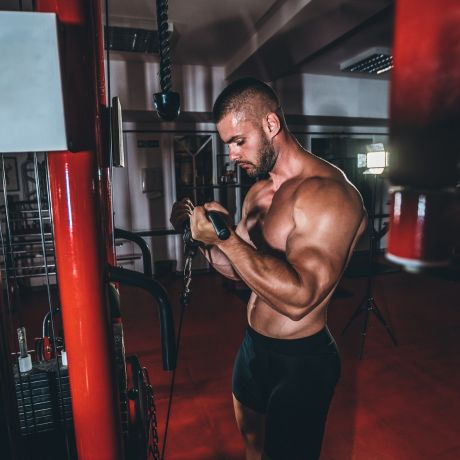
The Final Word on Cable Machine Exercises
After reading this text, I hope you recognize the cable machine and all it might do. With the flexibility to supply constant tension, adjustable resistance, and a wide selection of exercises, cable machines could be a useful a part of a muscle-building routine. Don’t fret. Throwing in a number of cable movements won’t take away your barbell lovers membership. It’s all about progress. And if cable machines might help, it is smart to make use of them.






